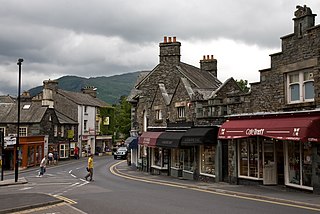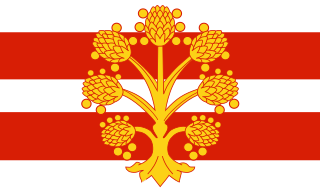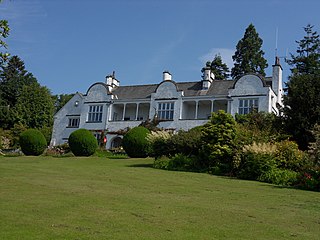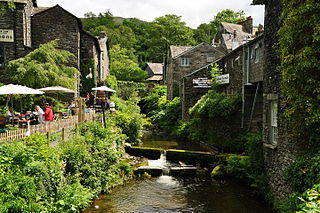History
Early years of the Trust

In 1939, Francis Scott of the Provincial Insurance Company in Kendal, purchased Brathay Hall estate, an 18th-century country house. [1] Scott wanted to protect the area from housing and business development and to devote the residence to a charitable cause. The events of World War II caused Scott to postpone his plans, until eventually Brathay Hall Trust was founded in 1946. [2] Scott saw a need for a leadership training and an activity centre, so offered Brathay Hall as a base for the National Association of Boys' Clubs. [2] He began running "Holidays with Purpose", a one-week course of outdoor education and cultural activities, including the production of newspapers and staging drama productions. [2] [3] The courses targeted boys from low socio-economic backgrounds who lived in cities in the north of Britain. [2]
In 1947, the Brathay Exploration Group was founded as an offshoot of Brathay Trust by geographer Brian Ware. Boys taking part in Brathay Trust programmes who had shown promise were recommended for the course, along with schoolboys, which partnered with universities to conduct field studies. [4] The group originated after a comment by geographer WV Lewis, who noted that many of the Lake District tarns had imperfect depth data collected on them. [3] The group conducted glacier surveys in Yugoslavia (now Slovenia), Norway and Iceland, and ornithology surveys on Foula in the Shetland Islands, and has continued to lead data collection expeditions well into the 21st Century. [4]

Due to the success of the single week courses, Brathay Trust launched an extended four-week course in 1950. [5] In response to the increased demand for programmes, Scott decided to finance many additions to the Brathay estate, including a boathouse, a theatre and extra dormitories. [2] Brathay sought to distinguish itself from the outdoor oriented charity Outward Bound, by focusing on a much broader range of activities. [1] [5] These courses were created after consultation with northern British industrial firms, who supported the courses as a way to bring out latent talent with the facilitation of well-rounded development for the youth of Postwar Britain. [5] The four-week course became the basis for Brathay activities until 1975. [1] Beginning in 1955, Brathay partnered with the Oxfordshire Education Authority to offer extended courses to schoolchildren from Oxfordshire, which blended history and geography lessons with outdoor education. [6]
Brathay's youth courses were praised by Geoffrey Crowther, Baron Crowther, the Chairman of the Central Advisory Council for Education, in his 1949 publication The Crowther Report, and similarly in the government produced Albemarle Report. In both reports, Brathay was praised for how their outdoor and physical activities had a strong youth appeal, motivating in a different way to conventional education. [7] [8]
Course diversification

In the mid-1960s, Brathay began to offer leadership and training and development programmes, targeted to adults from commercial companies, the government and other organisations. [2] In 1963, the Francis C. Scott Charitable Trust was set up, with Scott's son Peter acting as the trust's chairman. The trust was a major source of funding for Brathay during its early years, though over time, Brathay became less reliant on the Scott family funds until the current position where the two trusts are entirely separate financially. [9]
In the early 1970s, the courses were further developed by Peter Prior of Bulmers and John Adair of the Industrial Society, who saw great opportunities of developing the youth courses into industry-based adult courses. [1] Businesses such as the John Lewis Partnership developed annual staff development courses held at Brathay. [1] In the late 1960s with the help of the Industrial Society, Brathay's four-week courses were refocused, to relate the activities to the participants' lives, and decision making in general. [1] In 1967, Brathay opened the Field Study Centre, a one-week academic-focused programme for schools based at Brathay Hall, which continued to run until 1986. [1] In the 1970s and 1980s, a variety of programmes were created in the wake of increased unemployment in the United Kingdom, targeting youth skills acquisition, and youth rehabilitation. [1] [2] The courses were developed alongside the Trident Trust, and focused on youth who had not completed secondary school. [1]
The trust became an Accredited Training Centre by the UK government, and in 1977 became a member of the Development Training Advisory Group, alongside Outward Bound, Endeavour Training and the YMCA. The group was a consortium that encouraged quality practices in outdoor education courses and youth training. [1] [3] Brathay's youth offender rehabilitation work continued on into the 1990s, where the trust worked alongside the Breakthrough Foundation. [1]
In January 2012, Brathay Trust acquired a contract to manage two Lake District outdoor centres owned by the Wigan Metropolitan Borough Council, Low Bank Ground, close to Coniston Water and Hinning House in the Duddon Valley. Both properties had been in danger of sale or closure, and Brathay Trust will continue to manage the properties until 2019. As of 2021, Brathay no longer manages the properties. [10]


















